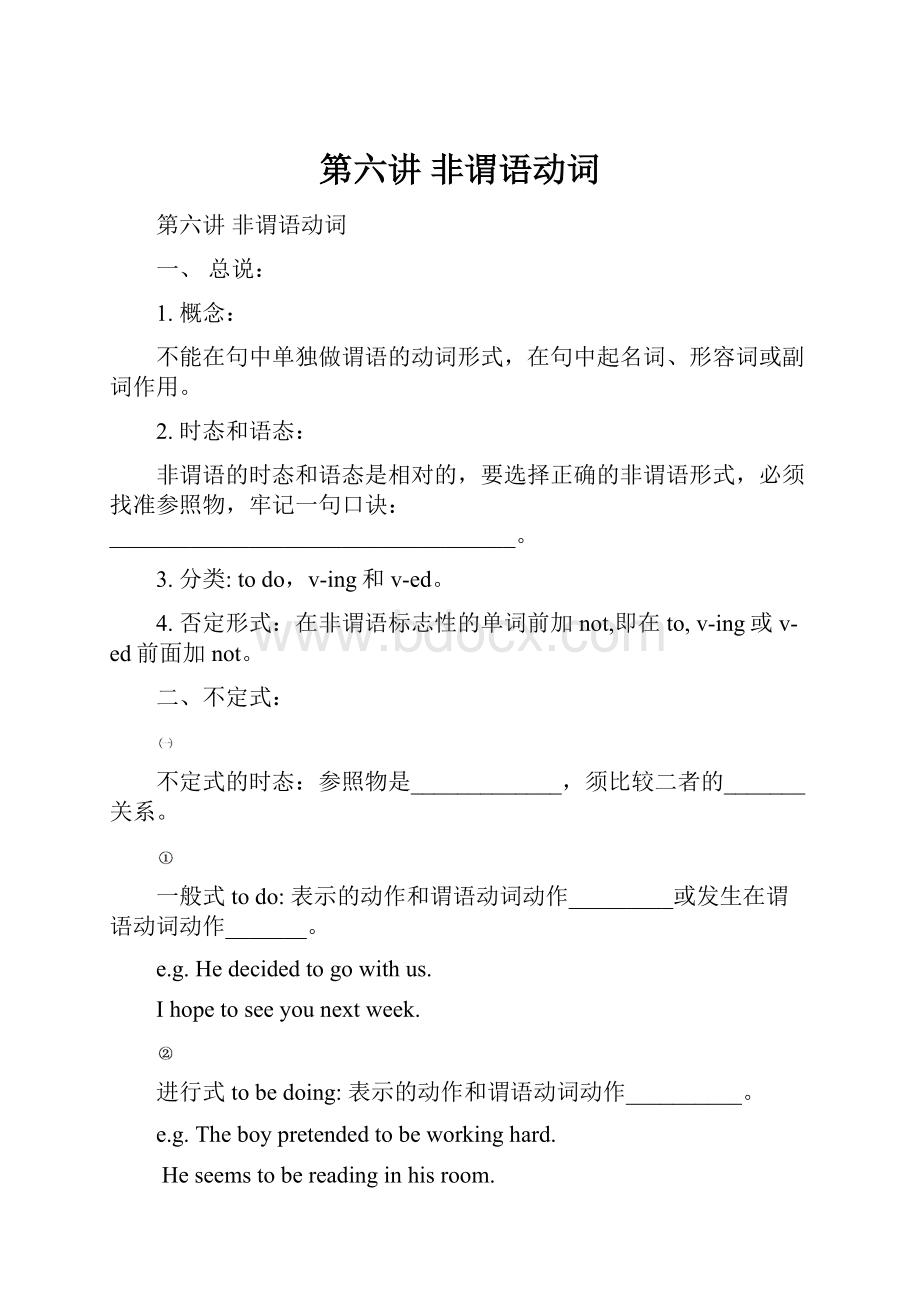第六讲 非谓语动词.docx
《第六讲 非谓语动词.docx》由会员分享,可在线阅读,更多相关《第六讲 非谓语动词.docx(21页珍藏版)》请在冰豆网上搜索。

第六讲非谓语动词
第六讲非谓语动词
一、总说:
1.概念:
不能在句中单独做谓语的动词形式,在句中起名词、形容词或副词作用。
2.时态和语态:
非谓语的时态和语态是相对的,要选择正确的非谓语形式,必须找准参照物,牢记一句口诀:
___________________________________。
3.分类:
todo,v-ing和v-ed。
4.否定形式:
在非谓语标志性的单词前加not,即在to,v-ing或v-ed前面加not。
二、不定式:
不定式的时态:
参照物是_____________,须比较二者的_______关系。
一般式todo:
表示的动作和谓语动词动作_________或发生在谓语动词动作_______。
e.g.Hedecidedtogowithus.
Ihopetoseeyounextweek.
进行式tobedoing:
表示的动作和谓语动词动作__________。
e.g. Theboypretendedtobeworkinghard.
Heseemstobereadinginhisroom.
完成式tohavedone:
表示的动作发生在谓语动词动作_______。
e.g.I’msorrytohaveinterruptedyou.
比较该句和I’msorrytointerruptyou.的区别:
不定式的语态:
参照物是___________,须比较二者的________关系。
e.g.a.Thelibrary__________nextyearisverybeautiful.(build)
b.Theroomseems___________________already.(tidyup)
注:
在easy,hard,difficult,pleasant,interesting等形容词后的不定式由于往往能补充出forsb.(即动作的发出者),所以通常使用主动形式:
e.g.a.Thewaterisnotfittodrink.
b.Thechairiscomfortabletositon.
c.Theproblemisdifficulttodealwith.
某些动词的不定式作表语,需用主动形式表被动含义:
e.g.a.Parentsaretoblameiftheirchildrendonothavegoodmanners.
b.Thehouseistolet.
不定式的句法功能:
动词不定式除了不能单独作谓语外,几乎能充当句子中所有的句子成分。
1.做主语,起名词的作用:
e.g.a.Tofinishtheworkintenminutesisveryhard.
b.Toloseheartmeansfailure.
动词不定式(短语)作主语时,常用it代替它作形式主语,例如上面两句可用如下形式:
Itisveryhardtofinishtheworkintenminutes.
Itmeansfailuretoloseheart.
不定式和动名词做主语的区别:
动名词做主语往往表示抽象的、一般的行为或动作,时间概念不强;不定式做主语常表示某次具体的行为或动作。
e.g.a.Doingsportsisgoodforpeople’shealth.
b.Todotoomuchexerciseisnotgoodforhimashehasaheartillness.
c.比较likedoing/liketodo,preferdoing/prefertodo的区别:
2.不定式作表语:
(1)表示主语的具体内容。
a.Hiswishistobecomeascientist.
b.Thedutyofapostmanistodeliverlettersandnewspapers.
注意:
主语部分有实义动词do时,表语中可以省略to。
Whathedidfirstwas(to)walkuptohisfriendandhughim.
(2)“betodo”还可以表示不同的情态意义。
a.Childrenarenottosmoke.(禁止)
b.Theyaretomarrynextweek.(安排)
c.Youmustbepatientandpersistentifyouaretosucceed.(决心或愿望)
d.Manistoliveabetterlifeinthenextcentury.(事态发展或预期的结果)
3.不定式做宾语:
(1)常见接不定式做宾语的动词:
afford,agree,aim,appear,arrange,begin,choose,come,dare,decide,demand,desire,determine,expect,fail,happen,help,hope,learn,long,manage,offer,plan,prepare,pretend,promise,refuse,seem,tend,want,wish等。
注意:
demand/hope只能接todo不能接sb.todo。
(2)形式宾语:
…feel/find/judge/make/think/believe/consider+it+adj./n.+todosth.
翻译:
a.互联网的普及使得人们的沟通变得方便又快捷。
b.我认为保护环境是每一个人的义务。
(3)在表示“希望、打算”等动词(如hope,expect,intend,mean,want等)的过去式后,可接动词不定式的完成式来表示没有实现的动作。
e.g.Wemeanttohavestayedthereaweek.(=Wehadmeanttostaythereaweek.)
4.不定式作宾语补足语:
(1)v.+sb.+todo
常见动词:
allow,ask,advise,beg,cause,encourage,expect,forbid,force,get,order,permit,persuade,teach,tell,want,warn,wish.
(2)v.+sb./sth.+tobe+adj./n.:
该句型中,tobe常常省略。
常见动词:
believe,consider,find,feel,imagine,judge,know,prove,think,suppose,understand
e.g.a.Hejudgedher(tobe)athief.
b.Weallconsiderthefilm(tobe)interesting.
5.不定式作定语:
(1)不定式做定语,放在所修饰的名词或代词后,相当于一个定语从句,表明动作即将发生。
e.g.a.Theconferencetotakeplacenextmonthwillcertainlybeagreatsuccess.
b.Thelibrarytobebuiltnextyearisverybeautiful.
(2)动词不定式作定语,注意以下几点:
①todo和tobedone做定语的区别:
a.Ihavealettertopost.
b.Ihavealettertobeposted.
c.Boss,doyouhaveanypapers_____________?
(type)
如果该不定式是不及物动词,其后应有必要的介词。
e.g.a.Shehasabighousetolivein.
b.Thelonelymanhasnoonetotalkto.
c.Atthattimeshecouldfindnoonetoturnto.
但:
Shehasnoplacetolive.
thefirst,thesecond,thelast,thebest,theonlything等常跟不定式作定语。
翻译:
a.他总是我们班第一个到教室的人。
b.这次他是我们班唯一一个通过考试的人。
6.不定式做状语:
表示目的:
不定式作目的状语时,一般放在句尾;有时如表示强调,也可置于句首。
置于句尾时,可以和inordertodo/soastodo替换,但置于句首时不能用soastodo替换。
不定式做目的状语时,否定式不能用not+todo,必须用inordernot+todo或soasnottodo。
e.g.a.Iopenedthewindowtoletsomefreshairin.
b.Inordertocatchthetrain,theytookataxi.
c.Let’shurrysoasnottobelateforthemeeting.
注:
在英语中,目的一般用不定式表示,不用for+doing这一形式。
e.g.Wewenttothestoretobuyabook.
or:
Wewenttothestoreforabook.
作结果状语。
不定式表示结果常见于下列句型:
onlytodo;so…astodo;such…astodo;enoughtodo;too…todo。
e.g.a.WhathaveIsaid__________yousoangry?
A.madeB.makesC.makingD.tomake
b.Thenewsreportershurriedtotheairport,onlytobetoldthefilmstarshadleft.(表示出乎意料的结果)
c.Wouldyoubesokindastohelpmecarrythebigbagforme?
表示原因:
常放在glad,happy,nice,generous,kind,selfish,silly等后面表示引发某种情绪的原因。
e.g.a.I’mtoohappytohearthat.
b.Weweresurprisedtohearthenews.
c.Youweresillynottohavelockedyourcar.
置于句首,作独立成分,如totell(you)thetruth,tobehonest/frank,tobegin/start/endwith,toconclude,tomakeitshort,tomakethings/matters/itworse。
e.g.a.Totellyouthetruth,Idon’tlikethewayhetalked.
b.Theliftofthebuildingwasoutofwork.Tomakeitworse,whenIhurriedtothecarpark,IfoundIhadleftthekeyinmyhome.
不定式的逻辑主语:
1.句子的主语就是不定式的逻辑主语。
Ihavemuchtodo.
.当句子的主语不是不定式的逻辑主语时,需要加上逻辑主语(for/ofsb.),构成不定式的复合结构。
在It’s+adj.+forsb.todosth.结构中,形容词往往表示事物的性质。
e.g.a.ItisimportantforustostudyEnglish.
b.Itiseasyforustogetthelatestinformation.
在It’s+adj.+ofsb.todosth.结构中,形容词通常表示人物的性格和特征。
e.g.It’sniceofyoutogivemesomuchhelp.(=Youarenicetogivemesomuchhelp.)
不定式的几点补充:
1.据说类句型:
※sb./sth.+issaid/reported/believed/thought/considered…+todo/tobedoing/tohavedonesth.
=Itissaid/reported/believed/thought/considered…thatsb./sth.willdo/isdoing/hasdonesth.
翻译:
a.据说他曾经去过很多国家。
Heissaid___________________________________.
Itissaid_____________________________________.
b.据报道这个歌星下周要到成都来。
Thepopsingerissaid___________________________.
Itisreported__________________________________.
2.疑问词+todosth.:
该结构常在句中充当一个名词的作用,做主语、宾语、表语等成分。
e.g.a.Howtostoppollutingtheriversisabigproblem.
b.Ireallydon’tknowwhattodowith/howtodealwithmyoldcomputer.
c.InthefaceofthefirstcrossroadsofmylifeIwaswonderingwheretogo.
3.不定式的省略:
(1)to的省略:
在下列结构中常用省to不定式:
a.hadbetterdosth.
b.wouldratherdosth.
c.havenothingtodobutdosth.
do/did/does/doing/donenothingbutdosth.
但:
havenochoice/option/alternativebuttodosth.
感官动词和使役动词后须接省to不定式,但这种句式在变为被动语态时应带to。
如see,watch,notice,hear,make,have,let等。
e.g.Thoughhehadoftenmadehislittlesistercry,todayhewasmadetocrybyhislittlesister.
help后的不定式做宾语或宾补时to可以省略,即:
help(to)dosth./helpsb.(to)dosth.
e.g.I’dliketohelphim(to)workouttheproblem.
(2)to后面的省略:
有时为了避免重复,不定式to后面的dosth.可以省略,但是to必须保留:
e.g.a.Ishallleaveifyouwishmeto.
b.Ifyouwish/want/liketo,Iwouldliketotreatyoutoteathisevening.
c.Heissuchasilentpersonthatheseldomsaysanythingunless_________.(speak)
d.---Doeshegotoschoolonfoot?
---No,butheusedto.
当to后面是be或完成时态标志词have的时候,___________________。
e.g.a.---Ishealazystudent?
---No,butheusedtobe.
b.---Didheattendthepartylastnight?
---He’d___________,buthewasverybusy.
A.liketoB.lovetohaveC.liketohaveattendedD.lovetoattendit
三、V-ing:
V-ing的时态和语态:
(回忆下前面讲述的口诀?
)
一般式doing/beingdone:
可以表示一般的动作、和谓语动作同时发生、在之前发生或之后发生几种情况。
e.g.a.Beingcarelessisnotagoodhabit,whateveryoudo.(一般动作)
b.Thestudentssurroundedtheteacher,listeningattentivelytoherstory.(同时发生)
c.Hearingthenews,thepoorlittlegirlburstintotears.(之前发生,强调______________)
d.Thedoctorinsistedongivingupsmokingandtakingplentyofexercise.(之后发生)
完成式havingdone/havingbeendone:
表示的动作放生在________________________。
e.g.a.Istillremember________________totheseaforthefirsttime.(take)
b._____________theletter,hefoldeditandputitintotheenvelope.(finish)
c._____________fromothercontinentsforages,Australiahasmanyuniquecreatures.(separate)
注:
某些V-ing可用一般式也可以用表示完成式表示动作发生在谓语动作之前:
e.g.a.remember/forgetdoingsth.=remember/forgethavingdonesth.
b.Thankyouforgiving/havinggivenussomuchhelp.
V-ing的否定式:
not+v-ing
e.g.a.Ifeelverydisappointedat____________toentertheroom.(notallow)
b._____________thehomework,theboyhadtostayathome.
A.HavingnotfinishedB.Nothavingfinished
C.NottofinishD.Notfinishing
V-ing的复合结构:
带有逻辑主语的-ing形式成为-ing的复合结构,在句中可以做主语、宾语或表语。
其中,做主语或表语时,逻辑主语只能使用名词的所有格或物主代词;做宾语时,名词所有格和普通格、代词主格和宾格均可。
翻译:
a.他前来帮忙大大鼓舞了我们。
b.使他很苦恼的是没有被允许进入会场。
Whattroubledhimmostis____________________________.
c.你是否介意他/Tom开窗户?
Wouldyoumind_______________________thewindow?
d.你很难想象如此小的男孩能在这么短时间完成任务。
Youcanhardlyimagine_____________________thetasksosoon.
e.医生建议我每天坚持锻炼。
(用两种方法翻译)
V-ing的句法功能:
V-ing在句子中可以作主语、宾语、表语、宾补、主补、定语或状语等成分。
1.作主语:
e.g.a.Shakingone’sheadmeans“no”andnoddingmeans“yes”.
b.It’sfunplayingwithchildren.
※常用it作形式主语,把V-ing置于句尾的句型有:
a.It’snouse/gooddoingsth..
b.It’suseful/uselessdoingsth..
2.作表语:
V-ing为动名词时,主语与表语通常是对等关系,可互换位置。
e.g.a.YourtaskislearningEnglishwell.
b.WhatIhatemostisbeinglaughedat.
c.Seeingisbelieving.
V-ing为现在分词时,表示主语的某种性质或状态。
e.g.Whattheteachersaidisveryencouraging.
3.作宾语:
(1)作动词的宾语:
有些动词只能用V-ing作宾语,常见这类动词包括:
admit(to),advise,allow,appreciate,avoid,consider,delay,deny,enjoy,escape,encourage,finish,forbid,imagine,keep,mention,mind,miss,practice,permit,resist,risk,suggest,understand等,其中有些可用sb./sth.doing结构。
注意:
A.advise,allow,forbid,permit,encourage可用不定式作宾语补足语。
e.g.Wedon’tallowsmo